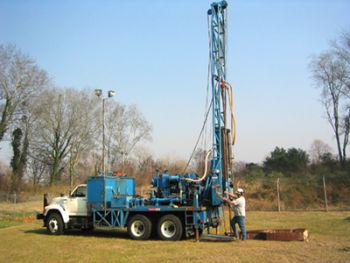Rotary Drilling: Difference between revisions
No edit summary |
Rmanwaring (talk | contribs) No edit summary |
||
| Line 17: | Line 17: | ||
"Types of rotary [[drilling]] include: | "Types of rotary [[drilling]] include: | ||
*direct rotary drilling; | *"direct rotary drilling; | ||
*reverse circulation rotary drilling; | *"reverse circulation rotary drilling; | ||
*dual-wall reverse circulation drilling; | *"dual-wall reverse circulation drilling; | ||
*core drilling."<ref name="NEH_CH5">[[National Engineering Handbook: Chapter 5 - Engineering Geology Logging, Sampling, and Testing | National Engineering Handbook: Chapter 5 - Engineering Geology Logging, Sampling, and Testing, NRCS, 2012]]</ref> | *"core drilling."<ref name="NEH_CH5">[[National Engineering Handbook: Chapter 5 - Engineering Geology Logging, Sampling, and Testing | National Engineering Handbook: Chapter 5 - Engineering Geology Logging, Sampling, and Testing, NRCS, 2012]]</ref> | ||
"A rotary [[drill]] advances a test hole by rapid mechanical rotation of the drilling bit (e.g., blade, tricone, and [[coring]] bits), which is made of carbide, tungsten, case-hardened steel, and diamonds. The bit cuts, chips, and grinds the material at the bottom of the hole into small particles. The cuttings are normally removed by pumping water or drilling fluid from a sump down through the drill rods and bit and up through the annular spacing into a settling pit and back to the sump. Compressed air is also available on many rigs as an alternative to remove the cuttings from the hole. Air rotary drilling is essential for drilling in karst areas where circulation loss is expected."<ref name="NEH_CH5" /> | "A rotary [[drill]] advances a test hole by rapid mechanical rotation of the drilling bit (e.g., blade, tricone, and [[coring]] bits), which is made of carbide, tungsten, case-hardened steel, and diamonds. The bit cuts, chips, and grinds the material at the bottom of the hole into small particles. The cuttings are normally removed by pumping water or drilling fluid from a sump down through the drill rods and bit and up through the annular spacing into a settling pit and back to the sump. Compressed air is also available on many rigs as an alternative to remove the cuttings from the hole. Air rotary drilling is essential for drilling in karst areas where circulation loss is expected."<ref name="NEH_CH5" /> | ||
Revision as of 22:52, 19 December 2022

|
| Drill Rig |
"One of the most important tools for subsurface exploration is a rotary drill rig complete with core barrels, diamond bits or hardened metal bits, and a hydraulic screw feed. The drill may be operated with a variety of samplers and bits, depending on the hardness of the material penetrated. Rotary drill equipment is manufactured in a wide variety of forms that vary from highly flexible to extremely specialized equipment, from lightweight and highly mobile equipment to heavy stationary plants, and range in size of hole and core from less than 25 mm (1 in) to 900 mm (36 in) or more in diameter. Normally, drill equipment is mounted in trucks but a wide variety of carrier units such as track, all terrain, and skid mounts are available. They are capable of drilling to depths of hundreds or thousands of meters depending upon the type of rig and the material penetrated."[1]
"Types of rotary drilling include:
- "direct rotary drilling;
- "reverse circulation rotary drilling;
- "dual-wall reverse circulation drilling;
- "core drilling."[2]
"A rotary drill advances a test hole by rapid mechanical rotation of the drilling bit (e.g., blade, tricone, and coring bits), which is made of carbide, tungsten, case-hardened steel, and diamonds. The bit cuts, chips, and grinds the material at the bottom of the hole into small particles. The cuttings are normally removed by pumping water or drilling fluid from a sump down through the drill rods and bit and up through the annular spacing into a settling pit and back to the sump. Compressed air is also available on many rigs as an alternative to remove the cuttings from the hole. Air rotary drilling is essential for drilling in karst areas where circulation loss is expected."[2]
"Rotary-drilling methods can advance test holes in a wide variety of materials, including hard rock. Rotary drilling may be the only practical method of advancing holes and obtaining undisturbed core samples from certain types of soil and rock materials."[2]
Best Practices Resources
Citations:
Revision ID: 6064
Revision Date: 12/19/2022
